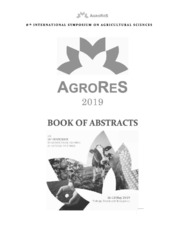Приказ основних података о документу
Weediness of soybean in different crop rotation
| dc.creator | Dolijanović, Željko | |
| dc.creator | Kovačević, Dušan | |
| dc.creator | Oljača, Snežana | |
| dc.creator | Simić, Milena | |
| dc.creator | Jovovic, Zoran | |
| dc.creator | Seremesic, Srdjan | |
| dc.date.accessioned | 2022-10-18T06:12:52Z | |
| dc.date.available | 2022-10-18T06:12:52Z | |
| dc.date.issued | 2019 | |
| dc.identifier.isbn | 978-99938-93-54-7 | |
| dc.identifier.uri | http://rik.mrizp.rs/handle/123456789/1008 | |
| dc.description.abstract | Increasing the soybean cultivated area is closely related to the intensification of crop rotation. The introduction of soybean as a legume crop has a positive effect on the weediness and yield of other crops, primarily maize and winter wheat. In order to prove the advantages of crop rotation in relation to the continuous cropping, a longer period of testing is required, i.e a certain number of rotations in each of the crops is required. This paper presents results of the effects of crop rotation on a weed community in soybean. A trial was settled on the experimental field of the Faculty of Agriculture, Radmilovac in 1992. The following cultivation systems have been observed: soybean continuous cropping, maize-soybean-winter wheat rotation (three crop rotation), and winter wheat-maize-soybean-spring barley+red clover-red clover-sunflower (six-crop rotation). The conventional cropping practices for cultivation of soybean were applied in continuous cropping and crop rotations. Crops are grown in non-irrigation regime, on chernozem luvic soil type. Long-term effects of various cropping systems on weed infestation were observed by the one square meter area method in 2015. The dominant species in continuous cropping and crop rotations were similar: Datura stramonium L., Solanum nigrum L., Amaranthus retroflexus L., Chenopodium album L., Sorghum halepense (L.) Pers and Convolvulus arvensis L. Scop. However, the number of weed species, the number of plants per weed species, fresh and air dry biomass was the highest in soybean continuous cropping and the smallest in three- and six crop rotation. In particular, there are large differences in the number of plants per weed species (in continuous cropping 43.8 and in crop rotation 12.6 and 12.8 per square meter) and in fresh weight (233.1 versus 96.9 and 108.2 g m-2 ). The 23-year continuous cropping was obviously a respectable period for making unambiguous and precise conclusions. Crop rotations, are more effective in suppressing the number of plants per weed species and decreasing biomass of weeds. | sr |
| dc.language.iso | en | sr |
| dc.publisher | Banja Luka : University of Banja Luka, Faculty of Agriculture | sr |
| dc.rights | openAccess | sr |
| dc.rights.uri | https://creativecommons.org/licenses/by/4.0/ | |
| dc.source | 8. International symposium on agricultural sciences "AgroReS 2019", Trebinje, 16-18.05.2019. - Book of abstracts | sr |
| dc.subject | continuous cropping | sr |
| dc.subject | crop rotation | sr |
| dc.subject | soybean | sr |
| dc.subject | weediness | sr |
| dc.title | Weediness of soybean in different crop rotation | sr |
| dc.type | conferenceObject | sr |
| dc.rights.license | BY | sr |
| dc.citation.spage | 47 | |
| dc.citation.epage | 47 | |
| dc.identifier.fulltext | http://rik.mrizp.rs/bitstream/id/4855/4.2019.pdf | |
| dc.identifier.rcub | https://hdl.handle.net/21.15107/rcub_rik_1008 | |
| dc.type.version | publishedVersion | sr |


